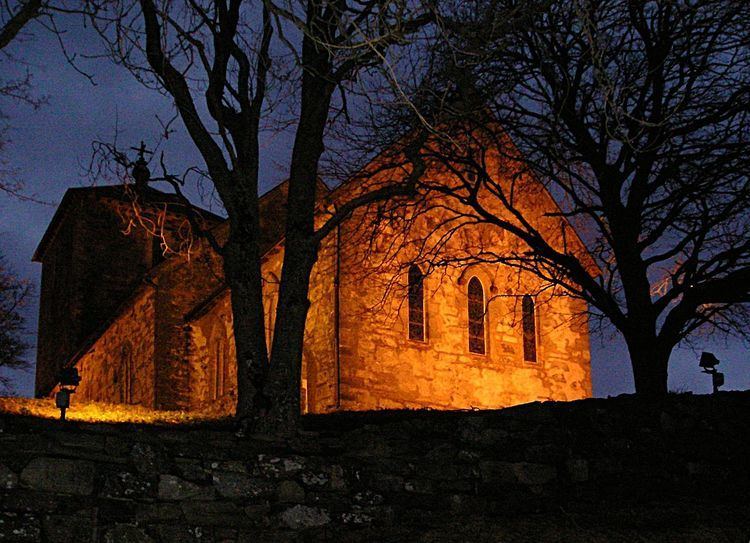Dedication Saint Olav Opened 1250 Phone +47 52 81 00 01 | Churchmanship Evangelical Lutheran Capacity 400 | |
 | ||
Similar Nordvegen History Centre, Åkra Church, Falnes Church, Haraldshaugen, The "Parliament" Stones | ||
Avaldsnes Church (Norwegian: Avaldsnes kirke, formally St. Olav's Church at Avaldsnes, Norwegian: St Olavskirken på Avaldsnes) is a parish church in Karmøy municipality in Rogaland county, Norway. The medieval stone church is located in the village of Avaldsnes on the northern part of the island of Karmøy. The first church located here was likely built before the year 1024 on the site of a royal estate. The present stone church was built in 1250 and it seats about 400 people. The church is part of the Avaldsnes parish in the Karmøy deanery in the Diocese of Stavanger.
Contents
History
Before this church was constructed, there was a wooden church on the same site around the year 1024. That church is assumed to have been built by Olav Trygvason, and it is possible that the present stone church is built around this church originally.
This church has been a landmark for seafarers passing through the Karmsundet strait for 750 years. King Håkon IV Håkonsson gave permission to build a church around the year 1250. It was not completed until nearly 1320, and was then the fourth largest in the country. The church was dedicated to St. Olav and received the status of "Royal Chapel". During the same period it became one of four "college-churches" (it appointed a council of theological and juridical scholars). Probably there was a group of four scholars and teachers in law and theology. There could be there was an octagonal house of stone in close proximity to the quire. Chapter Houses (Kapittelhus) were common for English cathedrals. This is assumed to have been referenced by clergyman and historical writer Peder Clausen Friis in 1599. Remaining walls were visible as late as 1840, but are now completely gone.
The history of the church depicts a fine cross-section of Norway's history. Being one of the largest churches along the coast of Norway, it is certain to have been visited by many travelers on their pilgrimage to St. Olav's shrine in Trondheim.
Decay started with the Black Death in 1349–1351. This disaster was followed by 400 years of Danish supremacy. In this period, the church gradually fell into a state of ruin due to lack of repair. By the 17th century a little wooden church was built inside the stone walls. This one was used for more than 200 years.
The first restoration work began in 1830. The old steeple was demolished, the nave was rebuilt, and a small wooden steeple was erected on the top. In the 1920s the church was once again restored in a manner which was more similar to its original architecture. A new stone steeple was built and the interior renewed.
The German occupation in World War II became dramatic for the church. The Germans asserted that the high steeple was used as a landmark for Allied planes, coming in over the strait of Karmsund to drop bombs in the water. German authorities demanded the steeple be demolished. Many people were engaged in the task of saving it, and they persuaded the Germans to let them camouflage the whole church with timber. This was to be done in 5 weeks, but the whole job lasted a year.
The 700th anniversary of the church in 1950 was a big event for the community, with concerts and a historical outdoor play which pictured the Viking history of the place.
The stained glass windows were ordered for the anniversary. They were made by Bernhard Greve, a Norwegian painter, and present the most important events in the life of Christ: Baptism, passion, ascension, and resurrection.
The altar, font, and pulpit were designed by Eivind Moestue in the 1920s. The baptismal basin dates back to the 16th century.
Design and architecture
The pointed arches, but thick walls and no pillars, suggest an early Gothic design. The walls are composed of ordinary gray stone in thickness about 1.2 to 2 metres (3 ft 11 in to 6 ft 7 in). The corners and frames around the doors and windows are of steatite (soapstone) from Tolgetjønn near Haugesund.
Mary's Needle
Mary's Needle, known in Norwegian as the sewing needle of Virgin Mary (Norwegian: Jomfru Marias synål) is the only one remaining of several monumental stones which once stood around the church area. The stone has been somewhat taller, but, towering at 7.2 metres (24 ft) it is still the next largest of its kind in Norway. The stone leans in towards the church wall—the distance to the wall is in fact only 9.2 centimetres (3.6 in).
A saga tells that "the day of Judgement will come when the stone comes into contact with the church wall". A popular story tells us about the minister in ages past climbing up the monument and cutting off a piece from the stone when it came dangerously near the church wall!
List of priests
Note: this list is not entirely complete, additionally medieval priests are only sporadically known.
